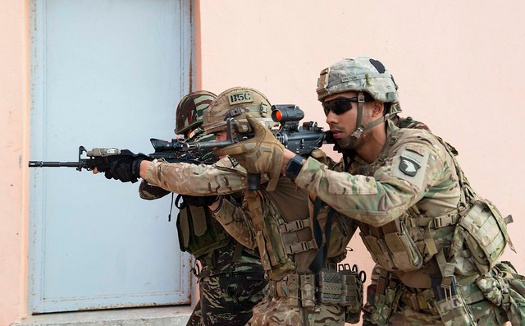 |
| June 04, 2019 | Volume 15 Issue 21 |
Designfax weekly eMagazine
Archives
Partners
Manufacturing Center
Product Spotlight
Modern Applications News
Metalworking Ideas For
Today's Job Shops
Tooling and Production
Strategies for large
metalworking plants
New cellphone, in-ear tech could help military locate shooter from the first shot

Members of the U.S. Army's 1st Squadron, 75th Cavalry Regiment, 2nd Brigade Combat Team, 101st Airborne Division; Moroccan special operations forces' 2nd Airborne Brigade; and British Army's 4 Rifles, Bravo Company, begin a room-clearing drill during the field training exercise portion of exercise African Lion 2019 in Tifnit, Morocco, March 26, 2019. New shooter locating technologies could help troops in both populated and remote locations. [U.S. Navy photo by Mass Communication Specialist 2nd Class Deanna C. Gonzales]
In the past several decades, militaries have worked hard to develop technologies that simultaneously protect infantry soldiers' hearing and aid in battlefield communication. However, these advanced Tactical Communication and Protective Systems, or TCAPS -- earmuffs or earplugs with built-in microphones allowing active hearing protection -- don't help if a soldier takes them off to assess the location of incoming gunfire.
Now, a French researcher has developed a proof of concept that uses the microphones in a TCAPS system to capture a shooter's acoustic information and transmit this to a soldier's smartphone to display shooter location in real time.
"At the beginning of an ambush, the most important thing for soldiers is to know where the shooting is coming from so that they can hide on the right side of a vehicle or at least aim in the right direction -- and they need this information very fast," said Sébastien Hengy, a combat acoustics researcher at the French-German Research Institute of Saint-Louis (ISL).
Hengy presented his TCAPS-based shooter location research ("Integrating acoustic shooter detection into a hearing protection device") at the 177th Meeting of the Acoustical Society of America on May 13, 2019, in Louisville, KY.
TCAPS have four microphones: two outside the ear canal and two inside it, underneath the hearing protection. In the French case, this is an electronic filter that activates to block out loud noises, such as when a soldier fires his or her own weapon.
Hengy's shooter location technology uses the fact that most modern combat weapons fire bullets at supersonic speeds, creating two acoustic waves. The first is a supersonic shock wave (similar to that formed in front of a jet at supersonic speeds) that travels in front of the bullet and propagates outward in a cone shape. The explosion of the bullet in the barrel creates a muzzle wave which radiates out spherically in all directions.
"Our system uses the microphone underneath the hearing protection in order to detect the shock and muzzle waves generated by supersonic shots and record the time difference of arrival of the Mach wave between the left and right ear. By combining the information sent by all the TCAPS deployed on the field, this gives you the direction of arrival of the waves and thus the direction in which the shooter is," explained Hengy.
This information is sent via Bluetooth or USB to a soldier's smartphone, which uses a data fusion algorithm developed by Hengy to calculate the shooter's position.
"If it's a smartphone with a good processor, the computation time to get the complete trajectory is about half a second," said Hengy, noting that once a soldier begins returning fire, the location system automatically turns off.
Soldiers in France's Operation Sentinel domestic anti-terror force are already equipped with smartphones.
To date, Hengy has successfully demonstrated the system with microphones mounted ear-width apart (about 10 cm) in a field, and is currently finessing the technology, including integrating head orientation information from tiny compasses mounted in the hearing protection.
Later this year, he and his partner team will begin tests with the system on an artificial head and, if all goes well, deploy the technology as early as 2021. The TCAPS technology is being developed in collaboration with French company Cotral.
Source: Acoustical Society of America (ASA)
Published June 2019
Rate this article
View our terms of use and privacy policy
